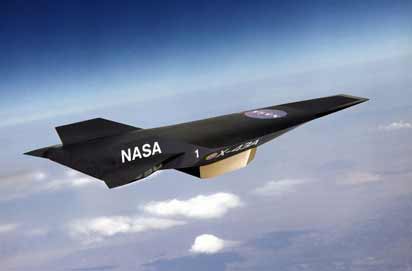Hypersonic: Aiming for Mach 10 on Autopilot

The faster a jet flies, the trickier it gets to maneuver. At supersonic speeds, one mistake can tear a plane apart.
At speed approaching 10 times the speed of sound — which experimental NASA craft have achieved — things get really dicey.
That sort of speed in mind, engineers have designed control system software to fly such hypersonic jets without a pilot, by adapting to changing conditions during a flight. It's not fully ready, but the work has advanced the capability significantly.
The latest supersonic combustion ramjets — called scramjets — burn air for fuel, and could one day carry people to space or around the world in a matter of hours, engineers say.
NASA’s X-43 hypersonic jet, in a 2004 flight, achieved Mach 9.8, or 7,546 mph.
- Image Gallery: What Breaking the Sound Barrier Looks Like
Lisa Fiorentini, a doctoral student in electrical and computer engineering at Ohio State University, along with associate professor Andrea Serrani are developing a new control system in collaboration with the U.S. Air Force Research Laboratory (ARFL) at Wright-Patterson Air Force Base in Ohio.
In the current issue of the Journal of Guidance, Control, and Dynamics, they report that their controller performed flawlessly in computer simulations of flight maneuvers.
Sign up for the Live Science daily newsletter now
Get the world’s most fascinating discoveries delivered straight to your inbox.
The controller both guides the jet along its trajectory and keeps it stable during a flight, Fiorentini explained. Sensors measure factors such as altitude, velocity, and acceleration, and the controller calculates whether any adjustments need to be made to keep the jet stable and on course. Then actuators carry out the controller’s commands — for instance, throttling up the engine if the jet needs to accelerate.
“Because these vehicles are unmanned right now, we have to prepare everything ahead of time — anticipate every possible in-flight event,” she said.
“And the controller has to work really fast. At 10 times the speed of sound, if you lose just one second, the jet has gone far, far off course.”
What sets the Ohio State control system apart, Serrani explained, is that it adapts to changing conditions during a flight.
"We consider a realistic, physics-based vehicle model within our stability analysis, using a highly sophisticated controller,” he said.
NASA had explored scramjets as a successor to the Space Shuttle for trips to the International Space Station. The X-43 project closed in 2004, as the space agency shifted its priorities toward a return to the Moon.
But the technology is still under development in military and commercial sectors. Scramjets could deliver missiles to mobile targets; they could also carry people halfway around the world in less than an hour. For this study, the engineers simulated two flight situations. In the first, simpler case, the scramjet had to climb from a level flight to 13,000 feet in a little less than six minutes. In a second, more complicated maneuver, it had to start at a few degrees off-kilter from a level flight, and then climb 25,000 feet in about four minutes. In both simulations, researchers recorded the controller’s tracking errors as the jet executed its maneuver. Then they compared the results to simulations using a controller they had developed previously -- one that did not have adaptive capabilities built in. For example, in the simpler maneuver, the largest altitude tracking error for the older, non-adaptive controller was just over 40 feet; the largest corresponding error for the new, adaptive controller was less than 2 feet – an improvement by a factor of 20. For the more complex maneuver, the non-adaptive controller failed -- the simulated jet spun out of control and crashed in less than four seconds. The new adaptive controller was able to guide the jet to its new altitude without incident.
The Ohio State and AFRL engineers are continuing to refine the controller. The next improvement will add some safety limits, Fiorentini said. Scramjets need to maintain the right amount of airflow to the engine, she explained, and if they rise too fast, the engine may stall in mid-air.










